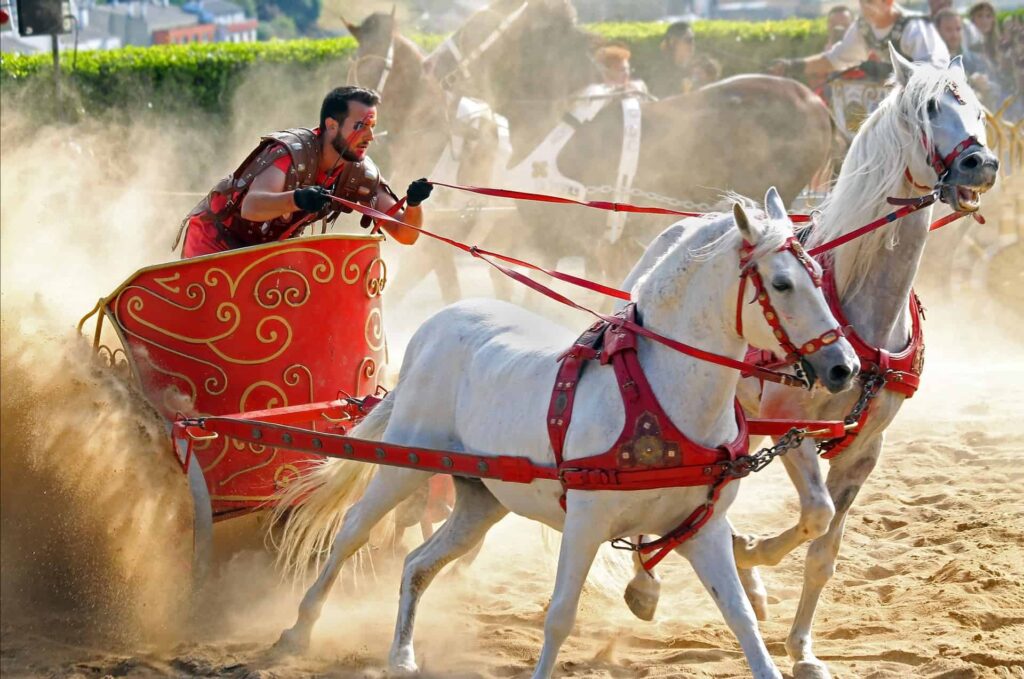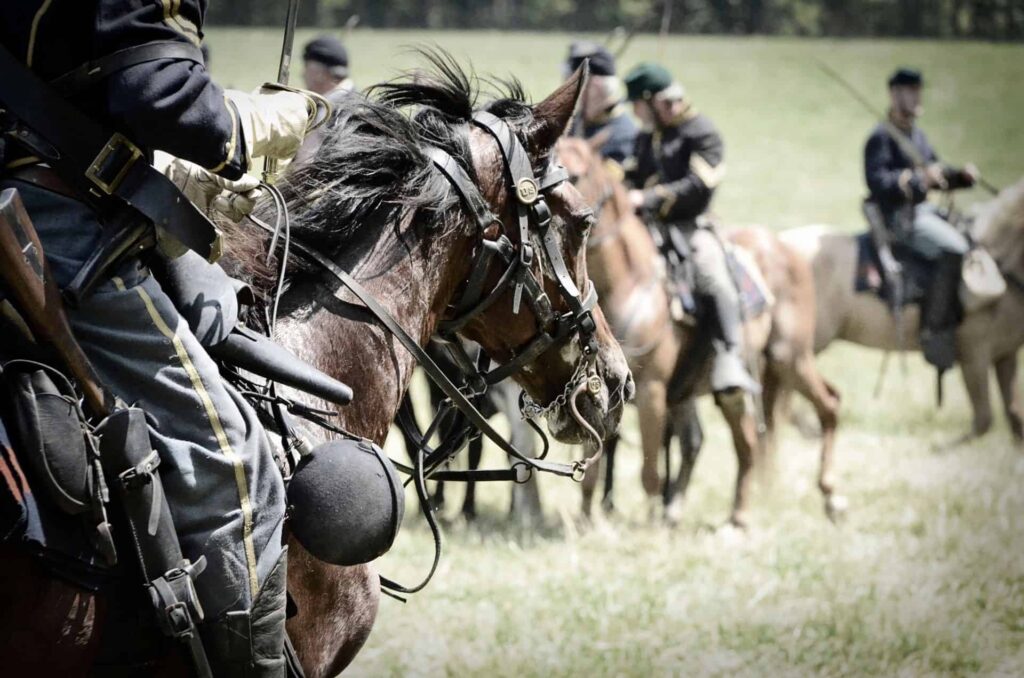Chariot warfare was a significant aspect of ancient military strategy, with its roots reaching back as early as 2000 BC. Originating in the Western Steppe and Mesopotamia, these lightweight, two-wheeled vehicles were crucial in revolutionizing tactics in various regions, such as Syria and Turkey. The use of chariots in battle provided a fast-moving platform to terrorize and scatter enemy forces, making them a sought-after asset on the battlefield.
Throughout history, different types and designs of chariots were developed to suit various tactical situations and terrains. These vehicles allowed for swift attacks with a range of short-range weapons, like javelins, spears, and axes. Moreover, chariots found application beyond warfare, featuring in hunting parties and even sporting events like the ancient Olympic Games.
The impact of chariot warfare on ancient societies is profound, with its influence visible in various aspects of culture, such as art, myths, and epic tales. These highly mobile war machines dramatically changed the course of history and shaped the evolution of warfare in subsequent eras.
Key Takeaways
- Chariot warfare dates back to 2000 BC and played a crucial role in ancient military tactics.
- Different designs and types of chariots were developed to accommodate various battle situations and terrains.
- The influence of chariot warfare extended beyond the battlefield, impacting various aspects of ancient societies and shaping the evolution of warfare in history.
Historical Context
Origin and Evolution
The chariot, an open two- or four-wheeled vehicle, was initially used in royal funeral processions before being employed in warfare, racing, and hunting. It is said to have originated in Mesopotamia around 3000 BC, with monuments from Ur and Tutub depicting battle parades that included heavy vehicles with solid wheels and wood-framed bodywork covered with skins. However, around 2000 BC, the light, horse-drawn, two-wheeled vehicles that would revolutionize tactics appeared in the Western Steppe, Mesopotamia, Syria, and Turkey.
By 1700 BC, war chariots carrying an archer and a driver equipped with a composite bow had a significant impact on military tactics. The use of chariots spread to various regions, including Greece, Asia Minor, Iran, India, and China. Chariot usage in warfare began to decline slowly around 1000 BC.
Ancient Egyptian chariots, specifically from the New Kingdom period (c. 1550-1070 BCE), were known to greatly impact warfare and were an integral part of military and cultural life. Fast-moving and lightweight, they enabled pharaohs to project their might and influence over extensive territories.
Significant Battles
Some notable battles involving the use of chariots include the Battle of Megiddo (Egyptian New Kingdom pharaoh Thutmose III, 1457 BC) and the Battle of Kadesh (Hittites and Egyptian pharaoh Ramesses II, 1274 BC). In both instances, chariots played a decisive role in the outcome of the battles.
The chariot’s reign came to a close by 500 BCE, as it was ultimately replaced by new military technologies such as cavalry, but it remained a symbol of power and prestige for some time after that. The chariot also continued to be used in sporting contests, such as the Olympic Games in Ancient Greece and the Roman Circus Maximus.
Chariot Warfare Techniques
Battle Formations
Chariot warfare played a crucial role in ancient battles, particularly in the Near East. Early chariots were usually pulled by two horses and carried a driver and a warrior armed with a bow, spear, or other projectile weapon. Battle formations varied, but commonly involved chariots arrayed in a line or in wedge-shaped formations designed to break through enemy ranks. They would often be accompanied by infantry and other supporting units. Chariot warriors would use their speed and mobility to outmaneuver enemy forces, exploiting gaps in defenses or flanking maneuvers to maximize their impact on the battlefield.
Tactics and Strategies
Effective use of chariots in warfare required a combination of tactical skill and coordination between drivers and warriors. Chariots were well-suited for hit-and-run tactics, using their mobility to rapidly engage and disengage from combat. In some instances, charioteers would use a tactic known as the Kedging run, where they would charge at the enemy, launch projectiles, and quickly retreat to avoid counterattacks. This allowed them to harass and weaken the enemy from a relatively safe distance.
Chariots were also used to support infantry and other units on the battlefield. Their speed and mobility allowed them to quickly move to areas where they were needed most and provide support in the form of rapid-fire missile attacks. In certain situations, chariots could be used to pursue and harass retreating enemy forces, ensuring they did not regroup and counterattack.
It is essential to note that chariots were not without their weaknesses and limitations. They were, in some cases, fragile and vulnerable, requiring level terrain for successful deployment. Hence, charioteers needed to carefully choose their engagements and terrain to exploit the full potential of these ancient war machines effectively.
Chariot Types and Designs
Chariot warfare was a crucial aspect of ancient warfare, and as a result, various chariot types and designs were developed over time. This section will discuss materials and construction, as well as variations across different cultures.
Materials and Construction
The construction of chariots typically involved using lightweight materials such as wood, leather, and bronze. Wood was primarily used for the frame and wheels, while bronze was used for reinforcing and decorative purposes. Leather was commonly used for straps and harnesses, connecting the horses to the chariot. These materials allowed the chariots to be light and fast, essential qualities for hit-and-run tactics in battle.
Wheels played a crucial role in the mobility of the chariot. Early chariot designs featured solid wooden wheels, which were later replaced by spoked wheels. This advancement made the chariot lighter and more maneuverable. Axles and suspension systems but could also vary depending on the terrain and intended use of the chariot.
Variations Across Cultures
Different cultures adapted chariot designs to suit their specific needs and environments. Here are some examples:
- Egyptian chariots: These chariots were known for their lightweight design and were predominantly used for archery. They usually featured two wheels, a small cab with room for a driver and an archer, and were driven by horses. Egyptians refined their chariots for speed, focusing on lightweight materials and efficient designs. (source)
- Hittite chariots: The Hittites, found in modern-day Turkey, used a heavier chariot design, better suited for their mountainous terrain. These chariots often featured three or four wheels and a more extensive cab allowing for additional soldiers or supplies. The Hittite chariot design focused on stability and the ability to maneuver in difficult landscapes.
- Chinese chariots: Chariotry was introduced to the Chinese steppes by the 14th century BC, and its designs varied significantly from those in Middle Eastern cultures. Chinese chariots often featured four wheels, and some were even enclosed for added protection. These chariots were not as fast or maneuverable as their counterparts in the Middle East but were more robust and better suited for the Chinese terrain. (source)
Chariot types and designs were constantly evolving across different cultures, reflecting the priorities and characteristics of each society. These variations allowed the chariot to remain a versatile and effective instrument of warfare for centuries.
Impact on Ancient Societies
Economic Aspects
Chariot warfare had significant economic impacts on the ancient societies where they were utilized. The light, horse-drawn, two-wheeled vehicles transformed tactics and spurred the development of various industries. The production of chariots required skilled craftsmen and created a demand for resources such as metal, wood, and leather. These materials were used not only for constructing the chariot itself but also for the harnesses, wheels, and associated weaponry (source).
The maintenance and use of chariots in warfare necessitated a consistent supply of horses, which in turn drove the growth of horse breeding and training industries. These economic activities contributed to the expansion of trade and exchange networks, as societies sought the resources and expertise required to build and maintain their chariot forces (source).
Social and Cultural Influence
Chariots also had profound social and cultural influences on the societies that employed them in warfare. For example, during the New Kingdom period in Egypt (approximately 1570 to 1085 BCE), the mastery of chariot warfare contributed to the expansion and strengthening of the empire (source). The elite status of chariot warriors fostered a class of professional soldiers, and the military prowess they demonstrated on the battlefield played a significant role in determining social hierarchies.
The chariot’s impact extended beyond the battlefield, as it also became a symbol of power and prestige during the New Kingdom period in Egypt (source). Chariot imagery was featured prominently in art and monuments, reflecting the importance of these vehicles in the cultural fabric of the time. Additionally, the chariot was used in ceremonial contexts, such as processions and religious rituals, further solidifying its place in the social and cultural landscape of ancient societies.
Chariot warfare had wide-ranging effects on the economic, social, and cultural aspects of the ancient societies in which it was practiced. The development, maintenance, and use of these vehicles spurred economic growth and trade, while also shaping the social hierarchies and cultural expressions of the time.
Frequently Asked Questions
What were the main tactics used in chariot warfare?
In chariot warfare, chariots were primarily used to terrorize and scatter enemy forces by charging at them, threatening to run over foot soldiers, and attacking with a variety of short-range weapons such as javelins, spears, and axes. They served as a highly mobile platform, providing an advantage over infantry and cavalry in certain circumstances.
How did chariot design evolve over time?
Chariot design evolved over time to adapt to the needs and resources of the civilizations using them. Early chariot designs were heavier and more cumbersome, while later versions were lighter and more agile to enhance their speed and maneuverability. Improvements in materials and construction techniques allowed for stronger and more durable chariots as well.
Which civilizations were known for their use of chariots in battle?
Several ancient civilizations were known for their use of chariots in battle, including the Egyptians, Hittites, Chinese, and Indian civilizations. Chariots were an elite arm of ancient Indian armies during the Vedic and Epic periods, and they played significant roles in the warfare of the Egyptians and Hittites as well.
What were the primary weapons used by chariot riders?
Chariot riders typically utilized short-range weapons such as javelins, spears, and axes to attack enemy forces. Some riders were also equipped with missile weapons like bows, providing them with the ability to launch rapid and deadly attacks from a distance.
How did terrain impact the effectiveness of chariot warfare?
Terrain played a crucial role in determining the effectiveness of chariot warfare. Chariots were most effective in open and flat areas where they could maximize their speed and maneuverability. However, they were less effective in rough or uneven terrain, which could hinder their movement, and expose them to greater vulnerabilities.
What factors contributed to the decline of chariot use in battle?
The decline of chariot use in battle was influenced by several factors, including their high expense, small army size, and inability to cope with rough terrain. Additionally, advancements in infantry and cavalry tactics eventually rendered chariots less effective, and an over-reliance on one type of weapon and military strategy led to their eventual downfall in many civilizations.
Last Updated on October 3, 2023 by Nate Dewsbury



